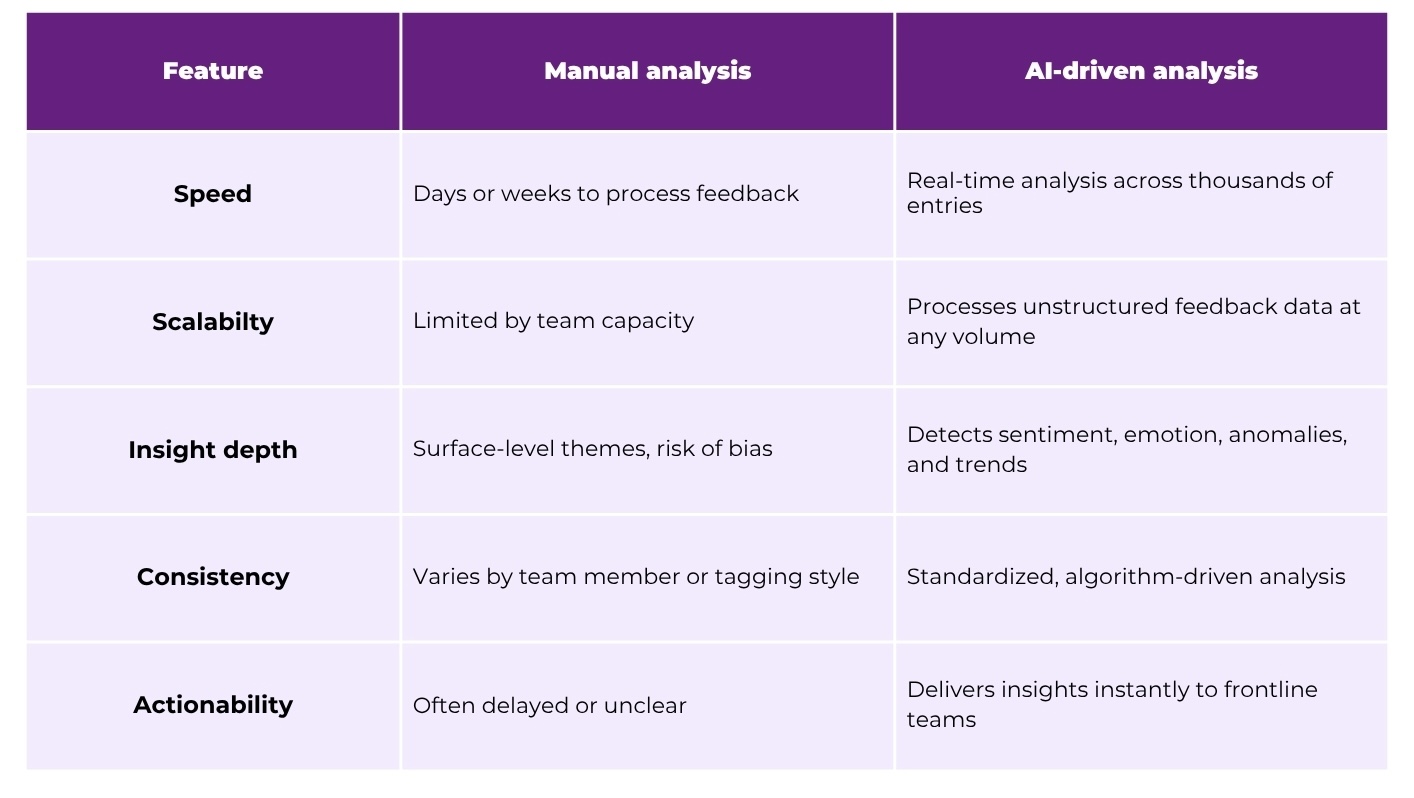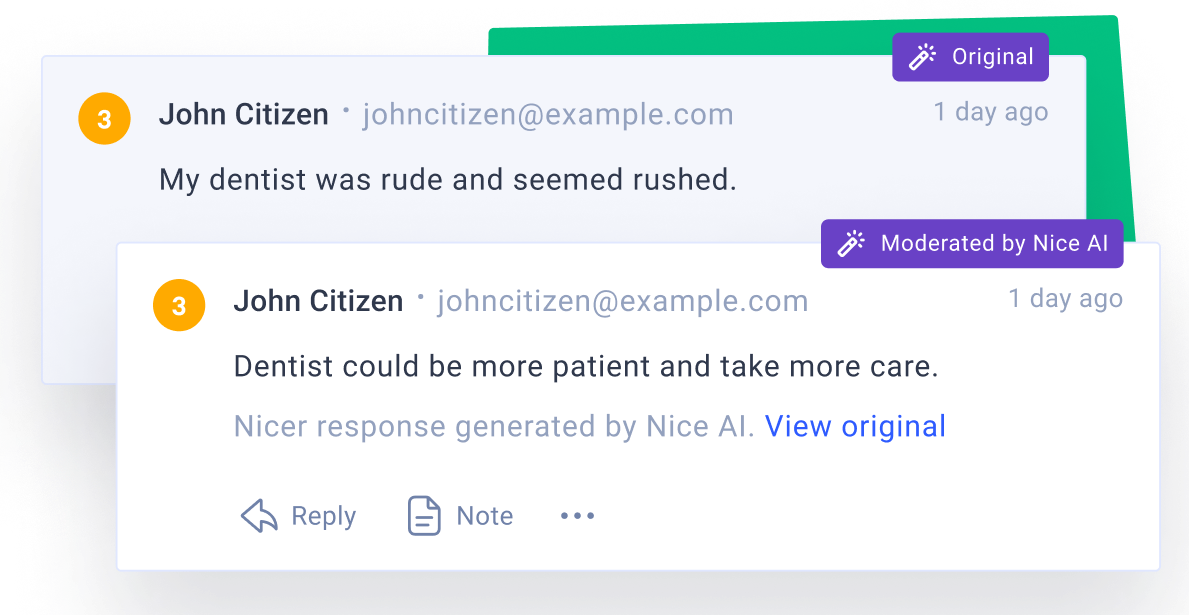
Customer feedback is supposed to be your North Star, but too often, it feels like a never-ending flood of data: hard to analyze, slow to act on, and stuck in silos across teams. While feedback is critical to improving customer experience, most companies struggle to turn it into real-time, meaningful action.
But AI is changing the game. As customer expectations rise and the volume of feedback increases, artificial intelligence provides a faster and smarter way to make sense of what your customers are saying, and critically, what you should do about it. With advancements in generative AI and natural language processing, service brands can now identify key themes, track sentiment, and surface customer insights across thousands of comments in seconds.
So, let’s explore how AI transforms every stage of the customer feedback lifecycle, from smarter survey collection to instant analysis and proactive follow-up. Along the way, we’ll highlight how AskNicely’s purpose-built tools like Dynamic Surveys, AI Theme Analysis, and frontline coaching help you close the feedback loop faster and deliver standout experiences at scale.
AI customer feedback refers to the use of artificial intelligence (specifically machine learning and natural language processing (NLP)) to collect, analyze, and act on customer input at scale. Unlike traditional methods that rely on manual tagging or slow, one-off customer surveys, AI tools can automatically process large volumes of written feedback, detect sentiment and emotion, identify recurring themes, and surface insights in real time.
It’s a faster, smarter way to understand what customers are saying, whether it’s a quick NPS comment, a long support ticket, or thousands of survey responses. By eliminating the manual grunt work, AI frees up teams to focus on what really matters: turning feedback into action.
Traditional customer feedback analysis is often slow, siloed, and reactive. Teams manually read through comments, tag themes inconsistently, and struggle to connect the dots across feedback channels. As a result, valuable insights get buried, and action comes too late, if it comes at all.
AI changes that. By automating the analysis of customer feedback, AI delivers scale, speed, and precision that manual methods simply can’t match.

Let’s explore a few of the key benefits in more detail:
AI enables customer feedback to be analyzed as soon as it comes in. No more backlogs, spreadsheets, or waiting for monthly reports. Whether it's 500 survey responses or 50,000 support tickets, AI tools can process them in real time and surface key insights instantly.
For customer experience and operations leaders, this means quicker informed decisions, faster recovery when something goes wrong, and more time spent acting on insights instead of chasing them down.
Open-text feedback is often where the gold lies, but it’s historically been the hardest to analyze. AI changes that use natural language processing (NLP) to understand sentiment, detect emotions, extract keywords, and identify anomalies automatically.
Product, marketing, and customer success teams gain a clearer, richer picture of what customers are really thinking, without having to manually read and tag every comment.
AI doesn’t just analyze feedback; it constantly monitors it. That means it can catch shifts in customer sentiment, highlight trending complaints or compliments, and alert teams to sudden spikes in specific customer issues.
Timing matters. Catching a recurring pain point or service issue early allows businesses to respond before it escalates, reducing churn and improving overall customer satisfaction.
One of the biggest advantages of AI-driven feedback isn’t just in what it uncovers, but in who it empowers. Instead of insights getting stuck in quarterly reports, AI can push real-time feedback directly to frontline staff with personalized suggestions or alerts.
This creates a closed feedback loop where frontline teams can continuously improve, feel more connected to the customer, and deliver better service, day in, day out.
When teams think about improving customer feedback, they often jump straight to analysis. But feedback is only as good as the data you collect, and this is where many businesses fall short.
AI can dramatically improve both the quantity and quality of feedback by personalizing the collection process, engaging customers in the right channels, and closing the loop with smart automation. At AskNicely, we’ve built AI directly into the collection process to help our customers gather more meaningful feedback without adding work for their teams.
Let’s look at three powerful ways AI is transforming how feedback gets collected:
Traditional surveys often ask the same static questions, regardless of customer context. That leads to low engagement, generic responses, and survey fatigue.
AskNicely’s Dynamic Surveys use AI to adapt in real time, personalizing questions based on previous responses, attributes, or customer behaviors. Whether it’s switching from a general NPS question to a follow-up about a specific location or tailoring questions for first-time vs. returning customers, AI makes the feedback feel more relevant and human.
The result: higher response rates, more thoughtful answers, and a feedback loop that actually reflects the customer’s experience.
.gif)
Customers expect to interact with your brand on their terms, whether that’s via email, text message, app notification, or live chat. AI makes it easier to manage feedback across all these touchpoints without overwhelming your team.
AskNicely integrates seamlessly with the tools your frontline teams already use (like point-of-sale systems, CRMs, helpdesk platforms, and mobile apps) so you can collect feedback at the right moment, in the right channel.
And thanks to AI, delivery can be optimized based on behavior and engagement patterns (e.g., choosing the best time or method to send a survey).
Meeting customers where they are = more responses + better context for action.
Ever had customers start a survey but never finish? Or seen a low score come in with no way to respond quickly? AI can solve both problems.
With AskNicely, AI detects when a customer hasn’t responded or when a response signals potential churn and triggers automated follow-ups. These can include reminder emails, thank-you messages, or even escalations to support or management teams.
Through integrations with your CRM or helpdesk, AskNicely ensures that the right person sees the right feedback at the right time, turning partial data into a complete, actionable story.
The outcome: richer data sets, faster recovery actions, and stronger relationships with customers.
Many businesses are sitting on a goldmine of customer feedback, yet struggle to do much with it. The problem isn’t the lack of data, it’s the lack of insight. Without the right tools, combing through open-text comments and interpreting trends is time-consuming, reactive, and often incomplete.
This is where AI steps in.
By automating the analysis process, AI helps customer experience (CX) and operations teams quickly identify what matters most—whether it’s a product flaw, an emerging training gap, or a brewing retention risk.
At AskNicely, we’ve built powerful AI tools that make sense of customer feedback in real time, without requiring a data science degree.
Let’s explore some high-impact use cases:
At its core, sentiment analysis uses natural language processing (NLP) to evaluate whether a customer’s comment is positive, negative, or neutral. But modern AI goes deeper, identifying emotions like frustration, urgency, or delight that add nuance to the feedback.
AskNicely uses AI to not only detect sentiment but also surface emotional context. For example, a comment like “I waited 10 minutes for help” might not include strong language, but AI can detect it as urgency, prompting faster action than a passive complaint.
Our moderation features also use AI to automatically reframe harsh or emotionally charged feedback for frontline coaching. Handling offensive or unconstructive feedback is tough for any team. NiceAI steps in to rephrase this type of feedback, transforming negative language into helpful, constructive criticism. This allows your teams to focus on actionable insights instead of hurtful messages, creating a more positive and productive customer service environment.

One of the biggest challenges in feedback analysis is recognizing recurring issues at scale. Reading through thousands of open-text responses manually just isn’t practical.
AskNicely’s Theme Analysis uses AI to detect and group comments around common topics, like wait time, staff friendliness, or product usability. These clusters evolve and improve as more data is collected, helping businesses spot long-term trends and emerging issues faster than ever.
Want to know if location A is struggling with the speed of service while location B is getting rave customer reviews about staff attitude? AskNicely’s themes make it crystal clear.
This is a game-changer for prioritizing product fixes, improving team training, and tailoring communications with real customer language.
AI doesn’t just analyze the past; it can help predict the future. By recognizing patterns in sentiment, response frequency, or declining net promoter scores (NPS) or customer satisfaction scores (CSAT), AI can flag at-risk customers before they leave.
For example, if a formerly enthusiastic customer has provided three lukewarm survey responses in a row, AskNicely’s AI can flag the account for proactive outreach, triggering an alert, support ticket, or personalized follow-up.
This gives your team a chance to intervene early, fix issues, and retain revenue that would have otherwise been lost.
Insight becomes action, and action becomes impact on your bottom line.
AI has the potential to completely transform how businesses collect, analyze, and act on customer feedback, but like any powerful tool, it needs to be used thoughtfully.
While AI can offer unmatched speed and scale, it also comes with real considerations: from data quality and bias to ethical use and over-automation. To make the most of AI while avoiding the common pitfalls, here are a few best practices every CX and operations leader should keep in mind.
Before jumping into AI-powered feedback analysis, teams need to agree on what success looks like. Are you aiming to reduce customer churn? Improve NPS? Coach employees more effectively? The more specific the goal, the easier it is to measure ROI and stay focused.
AskNicely helps teams define and track these goals through customizable dashboards that link frontline performance with customer sentiment. Whether you’re trying to raise location-specific NPS scores or improve post-service feedback response times, AskNicely gives you visibility into how AI-driven insights translate into real-world improvements.
Pro tip: Use your CX goals to guide what AI tools and features you prioritize, whether it’s sentiment analysis, theme extraction, or predictive alerts.
AI is only as good as the data you feed it. If your customer feedback is sparse, inconsistent, or biased toward a certain channel or customer type, your insights will fall short.
Start by improving your feedback collection methods. AskNicely’s Dynamic Surveys optimize question flow in real time, tailoring each survey based on who the customer is, how they’ve responded in the past, or what journey stage they’re in. This ensures your AI has rich, diverse data to work with, leading to better, more actionable results.
Better questions = better data = smarter AI insights.
AI should support decision-making, not replace it. While AI can quickly surface trends and suggest next steps, human context and empathy are still essential, especially when coaching teams or responding to sensitive feedback.
AskNicely’s platform is built on a human + AI model. For example, frontline managers can review AI-generated summaries and sentiment scores, but still dive into individual comments for nuance. The platform’s coaching tools encourage this hybrid approach, pairing smart insights with real conversations that help teams improve.
The best results come when AI amplifies (not overrides) human judgment.
Customer feedback often includes personal experiences, sensitive situations, or identifying information. That makes data privacy and ethical AI use non-negotiable.
Look for platforms that are transparent about how data is handled, how AI models are trained, and how bias is mitigated. AskNicely is committed to a privacy-first approach, ensuring customer data is never sold, anonymized where needed, and only used in the service of improving the experience.
At AskNicely, we believe that customer feedback should do more than sit in dashboards; it should drive real behavior change on the front lines.
That’s why we’ve built a suite of AI-powered tools that help businesses collect, analyze, and act on feedback in real time. From smarter surveys to frontline coaching, every feature is designed to make the customer experience (CX) more responsive, more personalized, and more effective.
Here’s what sets our AI approach apart:
The result? A faster, smarter, and more human way to improve customer experience.
If you're ready to see how AI can power your feedback strategy—and turn insights into action, book a demo today.